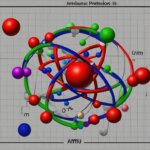Table of Contents
Mass in physics is a fundamental property of matter and holds great significance in the universe. It is a measurement of how much matter is present in an object, regardless of its shape or size. The concept of mass plays a crucial role in various scientific fields, from classical mechanics to astrophysics.
Mass is measured in kilograms (kg) and is determined by factors such as the total number, density, and type of atoms within an object. Different methods, such as inertial mass and gravitational mass, can be used to determine mass.
Inertial mass refers to the property of an object that resists acceleration. It can be observed by comparing the acceleration of two objects pushed under the same conditions with the same force. The object with lower mass will accelerate faster.
Gravitational mass, on the other hand, pertains to the measure of how much gravity an object exerts or experiences from another object. It is associated with the force of gravity acting on an object.
It is important to note that mass and weight are not the same. While mass remains constant, weight is the measure of the force of gravity on an object and can vary depending on the location. Weight is commonly measured in Newtons (N) and can be calculated using the formula weight = mass * acceleration due to gravity.
The law of conservation of mass is another key principle in physics. It states that the mass of a closed system must remain constant over time, regardless of any changes occurring within the system. This law has significantly contributed to our understanding of various phenomena and processes in the universe.
Throughout this article, we will delve deeper into the concept of mass in physics, exploring its fundamental properties, methods of measurement, the difference between mass and weight, and the significance of the law of conservation of mass in understanding the fundamental workings of the universe.
How to Measure Mass
Mass is a fundamental concept in physics and is typically measured in kilograms (kg). There are different methods to determine the quantity of mass, with two commonly used approaches being inertial mass and gravitational mass.
Inertial mass refers to how much an object resists acceleration. It can be observed by comparing the acceleration of two objects that are pushed under the same conditions with the same force. The object with lower mass will accelerate faster due to its lower resistance.
Gravitational mass, on the other hand, is a measure of how much gravity an object exerts or experiences from another object. It involves the gravitational force acting on an object and is associated with the concept of weight.
| Method | Definition |
|---|---|
| Inertial Mass | The measure of how much an object resists acceleration |
| Gravitational Mass | A measure of how much gravity an object exerts or experiences |
Scientists also use the atomic mass unit (u) to express mass in terms of atoms and molecules. One atomic mass unit is equal to 1/12 of the mass of carbon-12, which provides a standardized reference for atomic masses.
Comparing Inertial and Gravitational Mass
While both inertial mass and gravitational mass are measures of mass, they are conceptually different. Inertial mass relates to an object’s resistance to acceleration, while gravitational mass is associated with the gravitational force an object experiences.
However, according to the Equivalence Principle in physics, the inertial mass of an object is equal to its gravitational mass. This principle was famously confirmed by Albert Einstein’s theory of general relativity.
Understanding how to measure mass is crucial for various scientific disciplines, including physics, chemistry, and engineering. It provides a basis for studying the behavior of objects in different physical systems and exploring the fundamental properties of matter.
The Difference Between Mass and Weight
In the world of physics, it’s important to understand the distinction between mass and weight. While these terms are often used interchangeably in everyday language, they have different meanings when it comes to scientific measurements and calculations.
Mass refers to the amount of matter an object contains. It is a fundamental property of an object and remains constant regardless of its location. Mass is typically measured in kilograms (kg) and is determined by factors such as the number and type of atoms present in the object. It is an intrinsic property and does not vary based on external factors.
Weight, on the other hand, is a measure of the force of gravity acting on an object. It is influenced by both the mass of the object and the strength of the gravitational field in which it is situated. Weight is commonly measured in Newtons (N) and can vary depending on the object’s location. For instance, an object will weigh differently on Earth compared to outer space, where the gravitational field is weaker.
To understand the relationship between mass and weight, it’s important to recognize that weight is essentially the force experienced by an object due to gravity. This force can be calculated using the formula weight = mass × acceleration. In this equation, acceleration refers to the acceleration caused by gravity, which is approximately 9.8 m/s² on Earth.
It’s crucial to note that while mass remains constant, weight can change based on the gravitational field. This distinction becomes especially evident when considering scenarios like spacecraft in space, where the gravitational field is significantly weaker. In such cases, the mass of the object remains the same, but its weight decreases due to the reduced gravitational force acting upon it.
Understanding the difference between mass and weight is fundamental in physics. While mass represents the amount of matter within an object, weight measures the force of gravity acting on that object. By grasping this distinction, scientists and researchers can accurately analyze and interpret various phenomena in the physical world.

| Mass | Weight |
|---|---|
| Represents the amount of matter in an object | Measure of the force of gravity acting on an object |
| Remains constant regardless of location | Varies based on the location and strength of the gravitational field |
| Measured in kilograms (kg) | Measured in Newtons (N) |
| Dependent on the number and type of atoms within an object | Dependent on both mass and the strength of gravity |
The Law of Conservation of Mass
The law of conservation of mass is a fundamental principle in physics and chemistry. It states that the mass of a closed system remains constant over time, regardless of any changes happening to the objects within the system. This means that if you have a closed container with a certain mass of substances inside it, the total mass of those substances will always be the same, no matter what physical or chemical reactions occur.
This principle is crucial in understanding the behavior of matter in our universe. It allows scientists to predict and explain various phenomena and processes, from chemical reactions to nuclear reactions. The law of conservation of mass tells us that mass cannot be created or destroyed; it can only be rearranged or transformed.
For example, in a chemical reaction where substances combine or break apart, the total mass of the reactants will always be equal to the total mass of the products. Although individual particles may rearrange or bond differently, the overall mass of the system remains constant. This principle also applies to more complex systems, such as ecosystems, where matter is constantly recycled and transformed, but the total mass remains the same.
In summary, the law of conservation of mass is a fundamental concept that explains the constant mass of a closed system over time. It is a cornerstone of physics and chemistry, providing a basis for understanding the behavior and transformation of matter. By recognizing and applying this law, scientists can uncover the underlying principles governing the physical and chemical processes occurring in our universe.
FAQ
What is mass?
Mass is a fundamental property of matter and is a measurement of how much matter is in an object. It is determined by the total number of atoms, the density of the atoms, and the type of atoms in an object.
How is mass measured?
Mass is usually measured in kilograms (kg). There are different methods to determine mass, such as inertial mass and gravitational mass. Inertial mass is the measure of how much an object resists acceleration, while gravitational mass is the measure of how much gravity an object exerts or experiences from another object.
What is the difference between mass and weight?
Mass is the measurement of how much matter is in an object, while weight is the measure of the force of gravity on an object. The mass of an object remains constant, but the weight can change based on the location.
What is the Law of Conservation of Mass?
The Law of Conservation of Mass states that the mass of a closed system must remain constant over time, regardless of any changes happening to the objects within the system. This means that even if there are physical or chemical reactions occurring, the total mass of all the components involved will always be conserved.













